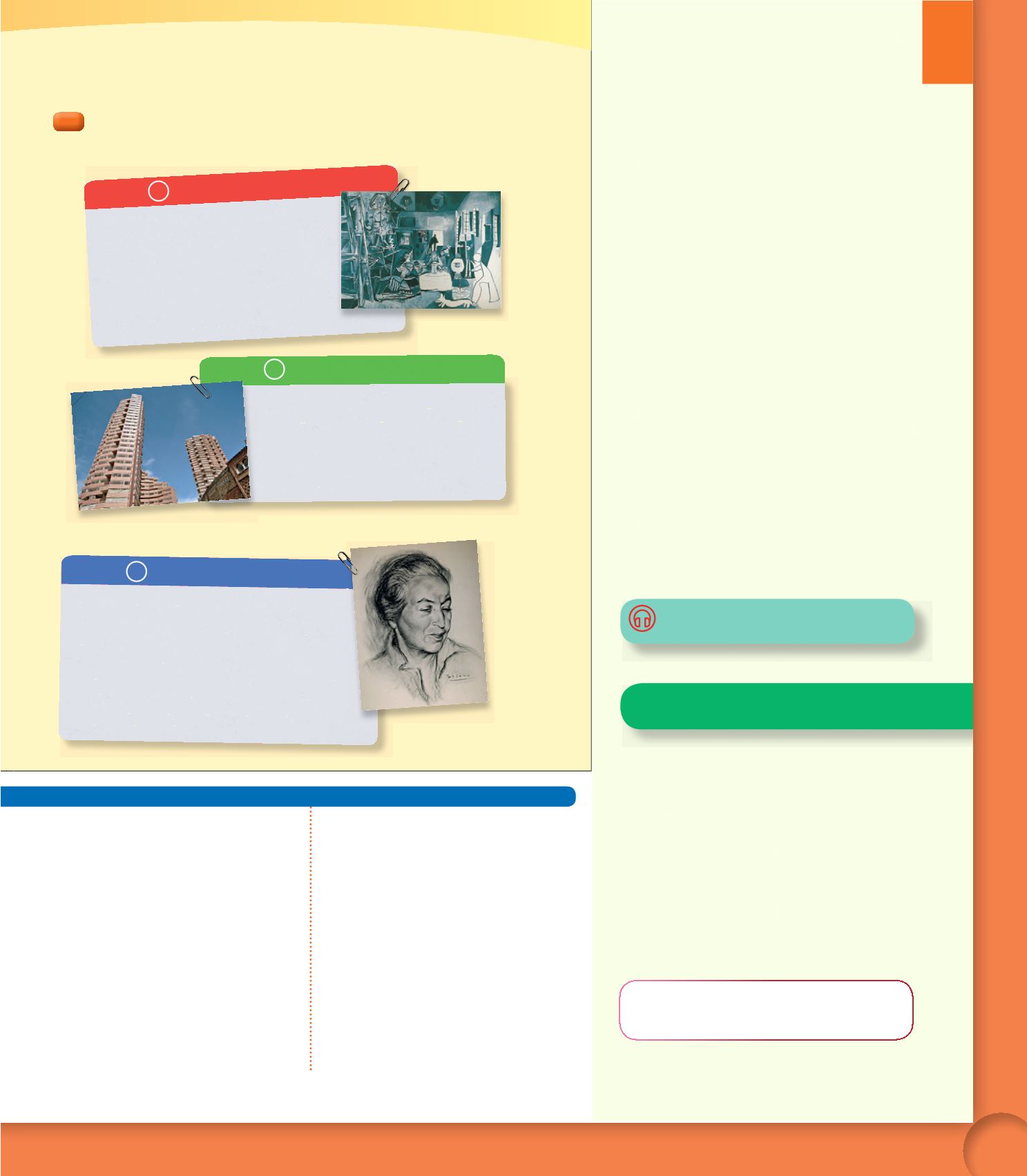

109
HERITAGE LANGUAGE LEARNERS
r
Ask students to describe a museum from
their heritage country. It may be an art
museum, a natural history or science
museum, or one dedicated to children’s
interests. Ask students to describe the
permanent collections featured or one
particular exhibit that was especially
successful. Ask students how visitors to
the museum can interact with the exhibits.
If there is no interaction, ask students to
describe how they would remedy this and
what they would like to see exhibited in
the future.
MULTIPLE INTELLIGENCES:
Visual-Spatial Intelligence
r
Explain to students that they are going to
create a
boceto
for a mural, and they will be
the subjects depicted in the art. Students
will represent scenes from their own past,
present, and what they perceive as their
future. They may choose to draw their
images or represent them with photos or
even images taken from the Internet. Ask
students to explain the significance of the
images and where they would like to exhibit
their work. Display students’ sketches
throughout the classroom.
Activities
78.
Before playing the recording, have students
read the statements and make sure they
understand the vocabulary. You may wish to
clarify that the Museo Reina Sofía is in Madrid,
Spain, and that it is named after the current
queen of Spain. You may also inform students
that this museum hosts one of Picasso’s most
famous paintings,
Guernica
. Next, have
students guess which of the statements may
be true and which may be false, and explain
why. For the third part of this activity, ask
students to compare and contrast their
opinions with those of their partner, and then
share them with the class.
79.
To expand this activity, you may want to ask
student pairs to prepare a brief presentation for
the class that includes photos, the description
and comparison of the two buildings chosen,
and two sentences recommending a visit to
the buildings.
80.
Display students’ work in the classroom and
have the class vote on the best entry in
each category.
AUDIO SCRIPT
See page 297N.
Answer Key
78.
1. C.
2. F. Las explican haciendo gestos.
3. F. No pueden pisarla.
4. C.
5. F. No son las obras más fáciles.
▶
Answers will vary.
▶
Answers will vary
79.
Answers will vary.
▶
Answers will vary.
80.
Answers will vary.
8
0
Los desafíos
¿Recuerdas los desafíos que Diana les planteó a los personajes? ¿Cuál te gusta más?
Elige una de estas opciones y resuelve tu desafío.
Tu desafío
DESAFÍO
A
Busca información sobre
Las Meninas
, el famoso
cuadro de Diego Velázquez. Luego, compáralo con
Las Meninas
de Picasso y haz una presentación.
Incluye estos datos:
r
Breve biografía de los pintores.
r
Época(s) en que fueron pintados los cuadros.
r
Estilo de los cuadros.
r
Tu opinión sobre los dos cuadros.
Pablo Picasso.
Las Meninas
(1957).
DESAFÍO
B
Elige un edificio o una escultura de un(a) artista
hispano(a) y graba una presentación para la
clase. Incluye:
r
Algunos datos biográficos.
r
Estilo y materiales empleados en la obra.
r
Tu opinión sobre la obra.
Rogelio Salmona.
Torres del Parque.
Bogotá (Colombia).
Busca información sobre un(a) escritor(a) hispano(a),
como Gabriel García Márquez, Octavio Paz, Mario Vargas
Llosa, Camilo José Cela o Gabriela Mistral. Prepara una
presentación que incluya:
r
Una breve biografía.
r
El argumento de una de sus obras más importantes.
r
Género y estilo de esa obra.
r
Una recomendación para que tus compañeros(as)
de clase lean esa obra.
DESAFÍO
C
Gabriela Mistral.
Para terminar
Unit
6
Additional Resources
Fans Online activities
341
Book 4 Unit 6


















